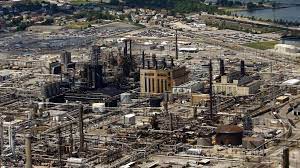When the skies opened up over Whiting, Indiana, on 19 August, it wasn’t just another summer thunderstorm. Nearly six inches of rain poured down in a matter of hours, flooding streets, shutting down schools, and overwhelming this small industrial town on the shores of Lake Michigan.
But for Whiting’s residents, the rain carried more than floodwater. The BP Whiting Refinery—the largest in the Midwest, processing 400,000 barrels of crude oil each day—was forced to shut down after the storm. Soon after, families living nearby began reporting a sickening mix of oil and gas fumes in their basements. Some said they felt dizzy. Others complained of nausea.
“The sludge they had to clean out of their system had to go through the water filtration plant,” said Carolyn Marsh, who lives within walking distance of the facility. “Who knows what they poured into Lake Michigan?”

A Community on Edge
BP acknowledged that conditions were “severe.” Sirens wailed at the refinery as residents worried about what might be leaking into their air and water. For many, it wasn’t just one bad storm—it was another reminder of the constant risks of living next to a massive oil refinery that has a history of accidents and environmental violations.
Just days later, the Indiana Department of Environmental Management confirmed the fears: floodwaters had left oil on the ground, and a hydrocarbon sheen stretched 50 feet along the shoreline of Lake Michigan.
For families in Whiting, that’s terrifying. The same lake provides drinking water for millions.
A Long History of Trouble
The 19 August flooding was only the latest in a series of safety scares.
-
In 2019, BP paid $2.75 million after violating federal air pollution limits.
-
In August 2022, a fire shut the plant down for over a week.
-
In December 2023, a gas pipeline leak left residents sick and angry.
-
In February 2024, a power outage forced another shutdown.
And decades earlier, in 2010, BP was responsible for the Deepwater Horizon disaster—the largest environmental catastrophe in U.S. history.
“It’s a really old facility, and that is very frightening,” said Lisa Vallee, who lives in Whiting and works with Just Transition Northwest Indiana. “We woke up the day after Christmas and it smelled terrible. People were getting sick. There was no word from BP for days.”
The Bigger Picture
What’s happening in Whiting highlights a larger, unsettling truth: refineries like BP’s are increasingly vulnerable to extreme weather. Scientists warn that the kind of storms that shut down the Whiting facility will only become more common as the climate crisis accelerates.
Yet many oil companies—including BP—have not disclosed how exposed their infrastructure is, or how they plan to adapt. For Whiting’s residents, that lack of transparency leaves them in the dark, living beside a facility they fear could one day cause a disaster too big to contain.
Fear and Frustration
While BP says it has “detailed plans” to manage severe weather, locals remain skeptical.
“We just cannot trust them,” Vallee said flatly.
Marsh put it even more bluntly: “We’re concerned that it’s going to blow up. They’ve had way too many accidents over the last few years.”
For Whiting, the storm may have passed—but the shadow of BP still looms large.




